Coins of the Realm
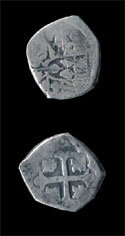
1 Reale

2 Reale
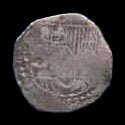
4 Reale

8 Reale
(Piece of 8)
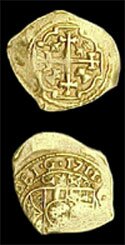
1 Escudo
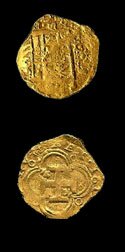
2 Escudos
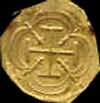
4 Escudos
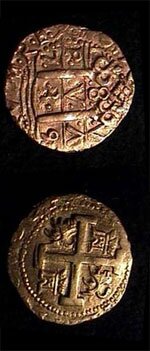
8 Escudos
(Doubloon)
Pieces of Eight and Doubloons - Reales and Escudos
During the Golden Age of Piracy, Spain minted coins in silver and gold. The silver coins were known as Reales (Reals) and the gold coins — Escudos (Escudo). The chart below shows the denomination of each coins minted. The famous "Piece of Eight" was an 8 reale silver coin that had a distinctive "8" stamped into it. It was the largest of the silver coins weighing approximately one ounce.
The gold coins were known as escudos and also came in a several denominations with the largest of these coins, the 8 escudo, weighing approximately one ounce.
The chart below gives the common Spanish Coins used in the American Colonies, including the English Colonies in North America. Contrary to the movies and books, the 8 reale coin was not normally called a Piece of Eight; it was more often referred to as a Peso, Spanish or Miller Dollar or simply Dollar[2]. This was especially the case in the English Speaking American colonies.
Doubloons
There is often confusion about what constitutes a doubloon. Doubloon comes from the Spanish Doblón which means to double; thus a doubloon is a coin of double value. As you can see on the chart below all Spanish coins double in value as you go from the smallest to largest denomination.
Some online sources claim that the 2 escudo coin is a doubloon while others claim it to be the 4 escudo. According to the 2002 edition of Encyclopedia Americana the doubloon was the 8 escudo coin[1]. Because gold coins were not commonly used among most of society it is possible that any Spanish gold coin could have been called doubloons by the common sailor or shop keeper. Doubloon was slang and was not used to officially denote any of the Spanish gold coins.
Each reale was minted to contained an approximate weight of 0.1209 to 0.125 ounces of silver. Each escudo was minted from 0.1209 to 0.125 ounces of gold. Thus 8 reales equaled one ounce of silver and 8 escudos equaled approximately one ounce of gold. The 8 escudo piece was also known as the Onza.
Ingots (bars) of gold starting at one ounce and increasing in size were also cast and stamped with a royal seal.
By comparison the British Shilling was 1/20 ounce of silver. Thus 20 shillings made up the British Pound (£). The British pound was the equivalent worth of the Colonial dollar ($) or piece of eight. (at least in weight) However, the British Crown frowned up foreign currency being used in its colonies and would often give a much lower rate of exchange on official transactions. By the time of the American revolution, Spanish or "Miller Dollars" as they became known were being exchanged at the rate of 4-8 shillings to the dollar. This is between 1/4 to 1/2 their actual value in silver!
Also by comparison there were 240 British pennies (240 pence) to £1.00 Stirling. Because of this the smaller British coins were often used interchangeably with the Spanish coins, 6 pence being worth slightly less than a 1/4 reale. The English 1/2 penny (pronounced hay-penny) was one of the smaller coins in common usage.
A Chart of Pirate Coins Worth
| Spanish Coin | Commonly called | Equivalent in Reales | Equivalent in Piece of Eight | Equivalent in Doubloons |
|---|---|---|---|---|
| 1/4 Reale | Cautorillo | 1/4 Reale | 1/32 P/E | 1/512 Doubloon |
| 1/2 Reale | 1/2 reale | 1/2 reale | 1/16 P/E | 1/256 Doubloon |
| 1 Reale | "Bit" | 1 Reale | 1/8 P/E | 1/128 Doubloon |
| 2 Reale | 2 Bits, (quarter) | 2 reale | 1/4 P/E | 1/64 Doubloon |
| 4 Reale | 1/2 dollar | 4 Reale | 1/2 P/E | 1/32 doubloon |
| 8 Reale | Duro, Peso, Dollar | 8 Reale | 1 P/E | 1/16 Doubloon |
| 1/2 Escudo | Escudito | 8 Reale | 1 P/E | 1/16 Doubloon |
| 1 Escudo | Escudo | 16 Reale | 2 P/E | 1/8 Doubloon |
| 2 Escudos | Pistole, (doubloon[1]) | 32 Reale | 4 P/E | 1/4 Doubloon |
| 4 Escudos | (doubloon[1]) | 64 Reale | 8 P/E | 1/2 Doubloon |
| 8 Escudos | Onza, Doubloon | 128 Reale | 16 P/E | 1 Doubloon |
Ever wonder why the coins aren't round?
It isn't entirely because of how old they are. Spanish money was originally minted by hand. The silver and gold was melted down and then poured out into thin strips. As the metal strips cooled they were beaten to desired thickness by hand. Then the coins were cut out to an approximate size. After this, the metal blank was placed in coin die (or stamp) and the top coin die was placed on top of the strip. Then the minter would strike the die with a hammer and the face and obverse (heads and tails) of the coin would be imbedded in the soft metal
After the coin was struck it would be weighed again and if it were over weight, small amounts of the metal would be nipped off. Later, a coin press was used. In this case the metal was placed between the two dies and they were pressed against the metal, cutting off the excess metal and making all the coins look pretty much the same.

The bar silver and the arms still lie, for all that I know, where Flint buried them; and certainly they shall lie there for me. Oxen and wain-ropes would not bring me back again to that accursed island; and the worst dreams that ever I have are when I hear the surf booming about its coasts or start upright in bed with the sharp voice of Captain Flint still ringing in my ears: "Pieces of eight! Pieces of eight!"
(The final paragraph from RLS, Treasure Island. For the lubbers out there, the sharp voice of Captain Flint was that of Long John Silver's parrot.)
[1] Wikipedia says the Doubloon is the 2 escudo coin however other sources say the 2 Escudo is known as the Pistole, The OED list the doubloon as the coin worth 2 pistole and the 2 escudo being the pistole. This would make 4 escudo coin a doubloon. In this instance the 8 escudo coin becomes the "double doubloon". Encyclopedia American, 2002 states "the gold doubloon (8 escudos, equal in worth to $16 dollars in U.S. Money) was the standard of large monetary transactions."
[2] In the American Colonies dollar was a common term used for silver coins worth approximately one ounce. Spanish Dollars were pieces of eight. Miller dollars were coins minted in the English colonies that resembled the size, weight, and quality of the Spanish dollars. The two coins were close considered interchangeable in most transactions. After the Revolution Miller dollars became the official coinage for the newly established United States. Spanish dollars continued to be used interchangeably with the new U.S. Dollars for several years after the revolution.

The only author and editor of all pages on the site. Most of what I write about is based on years of book reading on the topic. My first web page was published back in 1994.